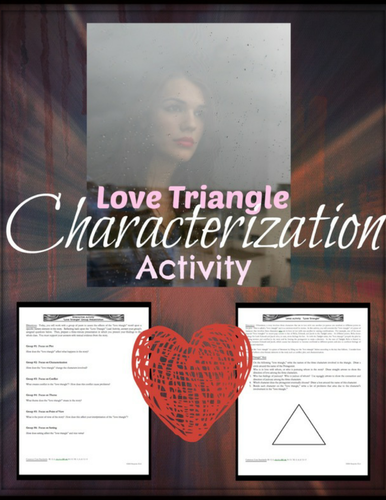
This listing is for a characterization activity entitled "Love Triangle" in which students analyze how a character's romantic relationships affect the story as a whole.
This mini-lesson is part of the Mega Characterization Bundle of over 15 characterization mini-lessons that get your students working with all literary devices and techniques. You can find it listed separately in our store.
Bundle and save over $15.00!
For this mini-lesson:
"Love Triangle"
Task
To assess the motif of the “love triangle” in a piece of literature and its effects upon literary elements
Objectives
To develop criteria for analyzing character
To assess comprehension of character development across a text
To support analysis with textual evidence
To assess how character interaction affects literary elements
To synthesize findings and present them to a group
Common Core Standards
R1-3, 6, 10, 11/ W1-4, 10-11/ SL 1, 4, 6/ L1-3
Instructions
Oftentimes, a story involves three characters that are in love with one another (or pursue one another) at different points in the plot. This is called a “love triangle” and is a common motif in stories (and sometimes this “love triangle” is quite bizarre—pun intended for the 80’s audience). In this activity, students will consider the “love triangle” of a piece of literature that involves three characters who are in love or lust with one another in varying combinations. For example, one of the most popular “love triangles” in recent pop culture is that of Bella, Edward, and Jacob in the Twilight series. At different points, Bella shows feelings for both Edward and Jacob who, in turn, show feelings for her. As with the Twilight series, the “love triangle” propels the plot by creating tension and conflict in the story and by forcing the protagonist to make decisions. In the case of Twilight, Bella is forced to choose between Edward and Jacob, which causes her character to become conflicted at different points in the story and also to confront feelings of jealousy and rejection.
In the “Love Triangle” Activity, students will consider the “love triangle” in a piece of literature in order to assess the dynamics of the relationships among the three characters involved. They will also consider how the “love triangle” motif affects other literary elements in the story such as conflict, plot, and characterization.
In the first follow-up activity, the “Love Triangle” Group Presentation, students focus upon a single literary element and determine how the “love triangle” affects that element in the story. Students are then to present their findings to the class using textual evidence. In the Exploratory Activity, the “Love Triangle” Poem, students write from the perspective of one of the characters involved in the “love triangle” in or
This mini-lesson is part of the Mega Characterization Bundle of over 15 characterization mini-lessons that get your students working with all literary devices and techniques. You can find it listed separately in our store.
Bundle and save over $15.00!
For this mini-lesson:
"Love Triangle"
Task
To assess the motif of the “love triangle” in a piece of literature and its effects upon literary elements
Objectives
To develop criteria for analyzing character
To assess comprehension of character development across a text
To support analysis with textual evidence
To assess how character interaction affects literary elements
To synthesize findings and present them to a group
Common Core Standards
R1-3, 6, 10, 11/ W1-4, 10-11/ SL 1, 4, 6/ L1-3
Instructions
Oftentimes, a story involves three characters that are in love with one another (or pursue one another) at different points in the plot. This is called a “love triangle” and is a common motif in stories (and sometimes this “love triangle” is quite bizarre—pun intended for the 80’s audience). In this activity, students will consider the “love triangle” of a piece of literature that involves three characters who are in love or lust with one another in varying combinations. For example, one of the most popular “love triangles” in recent pop culture is that of Bella, Edward, and Jacob in the Twilight series. At different points, Bella shows feelings for both Edward and Jacob who, in turn, show feelings for her. As with the Twilight series, the “love triangle” propels the plot by creating tension and conflict in the story and by forcing the protagonist to make decisions. In the case of Twilight, Bella is forced to choose between Edward and Jacob, which causes her character to become conflicted at different points in the story and also to confront feelings of jealousy and rejection.
In the “Love Triangle” Activity, students will consider the “love triangle” in a piece of literature in order to assess the dynamics of the relationships among the three characters involved. They will also consider how the “love triangle” motif affects other literary elements in the story such as conflict, plot, and characterization.
In the first follow-up activity, the “Love Triangle” Group Presentation, students focus upon a single literary element and determine how the “love triangle” affects that element in the story. Students are then to present their findings to the class using textual evidence. In the Exploratory Activity, the “Love Triangle” Poem, students write from the perspective of one of the characters involved in the “love triangle” in or
Something went wrong, please try again later.
This resource hasn't been reviewed yet
To ensure quality for our reviews, only customers who have purchased this resource can review it
Report this resourceto let us know if it violates our terms and conditions.
Our customer service team will review your report and will be in touch.
$3.00
